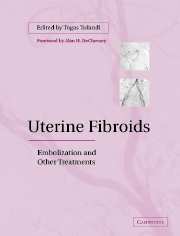Book contents
- Frontmatter
- Contents
- Contributors
- Preface
- Foreword
- 1 Uterine fibroids: epidemiology and an overview
- 2 Histopathology of uterine leiomyomas
- 3 Imaging of uterine leiomyomas
- 4 Abdominal myomectomy
- 5 Laparoscopic managment of uterine myoma
- 6 Hysteroscopic myomectomy
- 7 Myomas in pregnancy
- 8 Expectant and medical management of uterine fibroids
- 9 Hysterectomy for uterine fibroid
- 10 History of embolization of uterine myoma
- 11 Uterine artery embolization – vascular anatomic considerations and procedure techniques
- 12 Pain management during and after uterine artery embolization
- 13 Patient selection, indications and contraindications
- 14 Results of uterine artery embolization
- 15 Side effects and complications of embolization
- 16 Reproductive function after uterine artery embolization
- 17 Reasons and prevention of embolization failure
- 18 Future of embolization and other therapies from gynecologic perspectives
- 19 The future of fibroid embolotherapy: a radiological perspective
- Index
- Plate section
5 - Laparoscopic managment of uterine myoma
Published online by Cambridge University Press: 10 November 2010
- Frontmatter
- Contents
- Contributors
- Preface
- Foreword
- 1 Uterine fibroids: epidemiology and an overview
- 2 Histopathology of uterine leiomyomas
- 3 Imaging of uterine leiomyomas
- 4 Abdominal myomectomy
- 5 Laparoscopic managment of uterine myoma
- 6 Hysteroscopic myomectomy
- 7 Myomas in pregnancy
- 8 Expectant and medical management of uterine fibroids
- 9 Hysterectomy for uterine fibroid
- 10 History of embolization of uterine myoma
- 11 Uterine artery embolization – vascular anatomic considerations and procedure techniques
- 12 Pain management during and after uterine artery embolization
- 13 Patient selection, indications and contraindications
- 14 Results of uterine artery embolization
- 15 Side effects and complications of embolization
- 16 Reproductive function after uterine artery embolization
- 17 Reasons and prevention of embolization failure
- 18 Future of embolization and other therapies from gynecologic perspectives
- 19 The future of fibroid embolotherapy: a radiological perspective
- Index
- Plate section
Summary
The introduction of the laparoscopic approach for the management of intramural and subserosal uterine myomas has to a great extent revolutionized the modern management of myomas. Previously the only way to remove intramural and subserous myomas was by laparotomy, a procedure associated with significant postoperative morbidity. Therefore, physicians traditionally reserved abdominal myomectomy for a selected group of women where the risks and discomfort involved with laparotomy were judged worthy of the potential to preserve and enhance their fertility. Studies published in 1999 confirmed the advantages of laparoscopic myomectomy, such as the low morbidity and rapid recovery, which has led to the growing application of the technique towards women with symptomatic uterine myoma. However, laparoscopic operation is also associated with potential disadvantages including prolonged anesthesia, increased blood loss and possibly postoperative adhesion formation. This has led to a renewed interest in regard to the precise indications for performing laparoscopic myomectomy.
Indications
The primary reason for performing myomectomy in women of reproductive age is the preservation of the uterus for the purpose of childbearing. However, an increasing number of women currently elect to undergo laparoscopic removal of myomas, due to various symptoms associated with a rapidly growing or bulky uterus. In addition, some women resort to laparoscopic myomectomy when fibroids that are associated with heavy menstrual bleeding cannot be removed hysteroscopically.
- Type
- Chapter
- Information
- Uterine FibroidsEmbolization and other Treatments, pp. 41 - 49Publisher: Cambridge University PressPrint publication year: 2003

